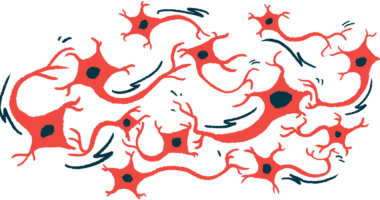Imaging agent detects toxic protein clumps in ALS brain, data show
AC Immune starts Phase 1 trial of PET tracer compound

ACI-19626, an experimental compound designed to be used as a PET tracer, can selectively bind to abnormal clumps of the protein TDP-43, a hallmark of amyotrophic lateral sclerosis (ALS), but not to normal TDP-43 protein, preclinical research showed.
Based on the promising early findings, ACI-19626’s developer, AC Immune, launched a Phase 1 trial (NCT06891716) to test the investigational imaging agent in healthy volunteers, as well as in people with ALS and other TDP-43-related diseases.
The trial, which aims to assess ACI-19626’s safety profile and pharmacological properties, is recruiting participants at a site in the Netherlands. Results are expected before the end of the year.
“Based on its advantageous profile, we took ACI-19626 forward into Phase 1 development and are looking forward to initial readout from that trial in [the fourth quarter of] 2025, as we continue to pioneer the precision prevention of neurodegenerative diseases,” Andrea Pfeifer, PhD, co-author of the new study and CEO of AC Immune, said in a company press release.
Pfeifer and colleagues described the preclinical development of ACI-19626 in the paper, “Development of [18F]ACI-19626 as a first-in-class brain PET tracer for imaging TDP-43 pathology,” published in Nature Communications.
Reliable tracer could aid in diagnosis, treatment monitoring
ALS is a neurodegenerative disease marked by the degeneration and death of the nerve cells that control movement, leading to progressive muscle weakness.
The causes of ALS are not fully understood, but in almost all cases, the disease is marked by abnormal clumps of TDP-43 protein in nerve cells. These clumps disrupt normal nerve function and are thought to play a key role in driving the disease.
A variety of experimental treatments targeting clumped TDP-43 are in development, but one of the hurdles for developing these therapies is a lack of reliable ways to measure TDP-43 clumps.
The team developed ACI-19626 as a PET imaging tracer to detect these abnormal protein clumps. Such a tracer could potentially aid in diagnosing TDP-43-related diseases and monitoring responses to treatment.
PET imaging uses radioactive dyes, called tracers, to detect specific substances in the body. The tracers are engineered to stick to a specific target, building up in parts of the body where the target is present. The PET machine can then detect the radioactive signal, indirectly measuring the amount of target.
In this case, ACI-19626 is designed to bind specifically to abnormal clumps of TDP-43.
“Accurate PET imaging of TDP-43 [disease] could significantly improve the diagnosis of multiple neurodegenerative diseases, paving the way to precision prevention with the possibility of intervening before damage occurs,” Pfeifer said. “This important diagnostic tool also has tremendous potential to improve the design and interpretation of clinical trials by enabling patient stratification, optimizing the timing of therapeutic intervention, and facilitating evaluation of target engagement and [pharmacological] effects.”
In patient-derived brain samples, the tracer was found to be specific to the abnormal clumped form of TDP-43 that marks ALS and other diseases. It did not bind to the normal, free-floating form of the protein, nor did it bind to clumps of other types of proteins.
Preclinical tests done in monkeys also indicated that the tracer has a pharmacological profile well suited for use in PET imaging. After being infused into the bloodstream, it was quickly distributed into the brain and then excreted from the body within hours.
The experimental compound shows “all the desired characteristics for the successful visualization of TDP-43 pathology in the human brain by PET,” the researchers concluded, though they noted that additional testing in people will be needed before this experimental molecule can be used in clinical practice.
“We strongly believe that the detection of TDP-43 pathology by PET could not only support earlier and more definitive diagnosis but also accelerate drug development and open new avenues for combination therapies,” said Francesca Capotosti, PhD, AC Immune’s vice president of research and co-author of the study.







